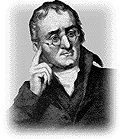 | "A series of Essays read before this society and afterwards published in the 5th Vol. of their Memoirs gradually led me to the consideration of ultimate particles or atoms & their combinations. Under the date of September 3rd, 1803, I find in my notebook 'Observations on the Ultimate Particles of Bodies and their Combinations,' in which the atomic symbols I still use [were] introduced. On the 23rd of October the same year[I] [r]ead my Essay on the absorption of gases [by water] at the conclusion of which a series of atomic [weights] was given for 21 simple and compound elements .. . . "
- John Dalton (Excerpt from paper read to Manchester Literary and Philosophical Society, 1830)
|  |
 | 
John Dalton is now called the father of modern atomic theory for his efforts. His atomic theories were introduced in 19th century England.
In September of 1803, John Dalton wrote his first table of atomic weights in his daily logbook. In 1830, he stated his most well-known quote (at the top of this webpage). Two years after he developed his atomic weights, he published them in a book called "A New System of Chemical Philosophy. In it he was the first to propose that elements be identified with symbols. However, only 3 or 4 pages in the third chapter discussed the atomic theory he proposed. In this theory, there are four basic ideas...
1) chemical elements are made of atoms.
2) the atoms of an element are identical in their masses
3) atoms of different elements have different masses
4) atoms only combine in small, whole number ratios such as 1:1, 1:2, 2:3 and so on.
5) atoms can be neither created nor destroyed
Interesting Fact: The unit for atomic weight was called a "dalton" for many years. Today, it is used in biochemical circles, (e.g. "The atomic weight of that protein is 35,000 daltons.")
|  |